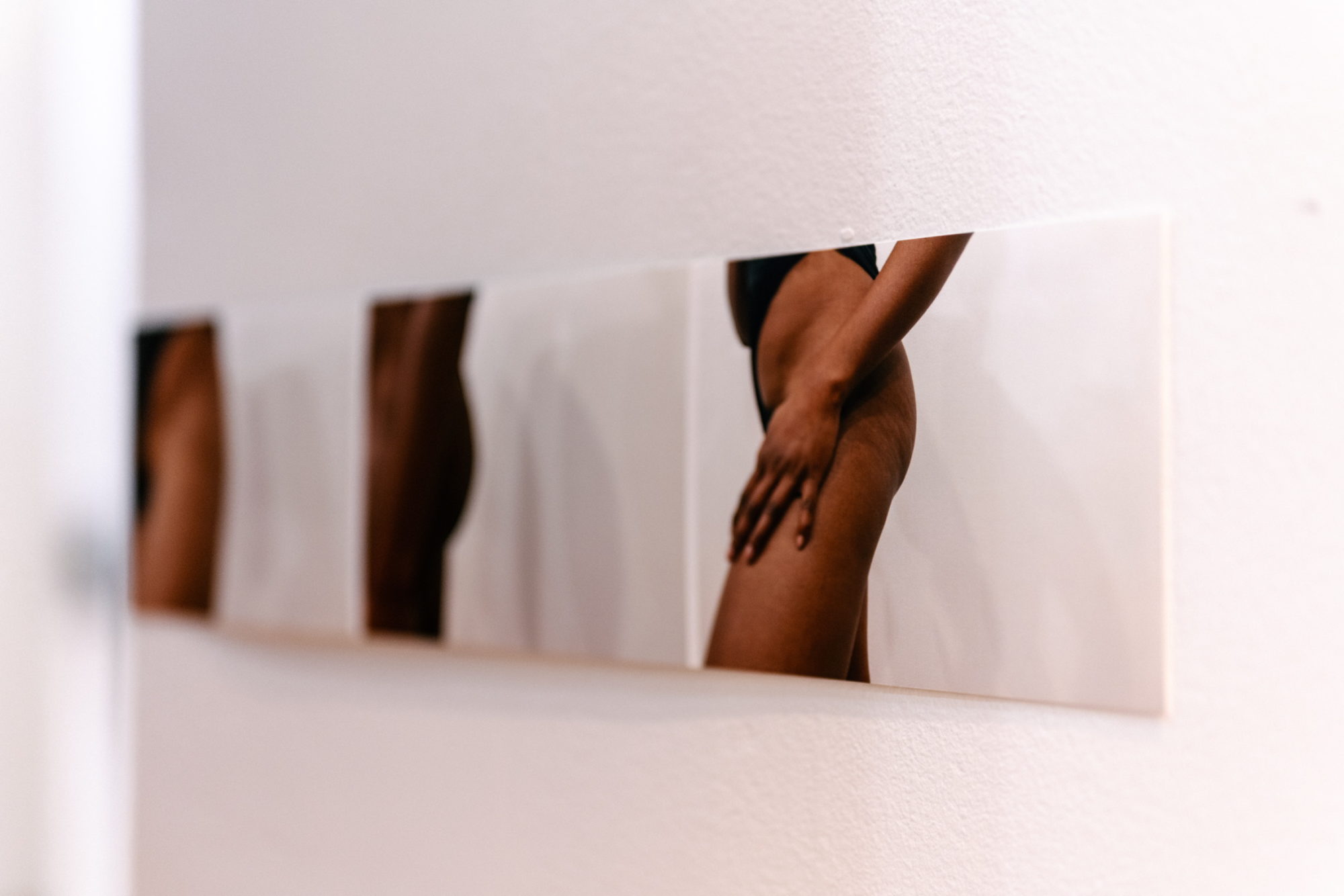Mara Duvra: To be seen / To be manifold
Reviewed by: Michael Kleber-Diggs
Juxtaposition Arts
Feb 11—Apr 6, 2019

WHEN YOU CONFRONT AN EITHER/OR HYPOTHETICAL CHOOSE BOTH (OR NEITHER)
imagine instead. imagine a beautiful fracture,
a wondrous contortion, a backbending arc.
consider holding an ecstatic shadow in your hands;
contemplate its temperature, its weight,
its suppleness, how it was manufactured,
how light it is. now clouds – decide.
decide they are radiant and warm.
make them dry like sheets on the wind, but heavy.
every thing is many things: context.
perspective: no thing is one thing.
every object exists beyond how it is perceived,
so you might as well imagine instead
imagine you also get to (re)define, then
do that. (re)define.
—Michael Kleber-Diggs
Mara Duvra’s To be seen / To be manifold dwells in softness: light, shadows, hazy plants, unidentifiable objects seen as if by x-ray, the linen of a bed – made and unmade, text visible behind text – layers of meaning, clouds – translucent and not – the intimacy of axillary hair, of curvy hips and breasts, of puffy round areolas and nipples; portals: windows, doors, door frames, doorways; white space within images, white space framing images, the white walls of the exhibit space, lightness, sunlight; a black woman in various stages of exposure, repose and rapture – her neck a vulnerability, an invitation to a private affair – her form a vision in ecstasy, her skin wealthy in color and tone, moisturized to a gleam. Eighteen images in total, all designed to highlight tenderness generally but tenderness specifically as it relates to women of color.
Particularly compelling among the images is the photo of a Black woman atop of and connected to a photo of a body of water. Her expression is simultaneously contemplative and rapturous. The choice renders the subject ascended and angelic or beatified. The vast water exaggerates her softness. Her naked torso suggests softness too. The two images considered together insist on adoration. The woman is loved and beloved; she is content to love herself. Her gaze also includes an element of longing. Longing, yearning and desire are persistent in the exhibit. The images are intimate, and considering everything – pedestrian objects like door frames, and more complex objects like clouds and human beings – Duvra makes a compelling argument against static ideas and limited perspectives.
What makes an object manifold? How does context encourage an object or subject to be seen and understood differently? In photography and in poetry, it’s a matter of cropping and spacing, what is within the image and what isn’t. Context is also a function of proximity, of focus and filters, of lighting and shade, of angle and closeness (or distance). What we choose to see, what we set it among, how it is manipulated, how it is arranged and exhibited, all these things form context.
In many ways, To be seen / To be manifold represents a further democratization of art. The images were shot on a cell phone and accompanied by found text – excerpts from poems. Duvra says she’s not a photographer and treats images as objects. She says this in a way that suggests anyone with a mobile phone can do it. This is a modest suggestion, one that minimizes art as theme and idea curation and cropping and context.
In other ways, To be seen / To be manifold, made by a Black woman, featuring a Black woman, and curated by a Black woman (Tia Simone-Gardner) might be seen to represent a case for more Black art or a response to an America increasingly controlled by fear and, in certain circles, increasingly willing to flirt with fascism and nationalism. The desire to be seen as more than one thing, the interest in tenderness for women of color, these both might be considered as rebuttal to limited ideas expressed elsewhere. Of course, that depends on who is speaking and to whom they are speaking. The work might also be seen as a celebration of something worthy of celebration in and of itself, a conversation among those willing and able to have it. All to say work that reminds us we’re complex and unique and worthy of tenderness has an urgency it should not have in this day and age. Let Duvra’s ideas and her decision to focus her work on women of color serve as a reminder for those who need it. Regardless of audience, Duvra’s art expresses an important truth for women of color living in a racist and patriarchal society: the ability to love yourself and see yourself as worthy and divine, these things are not only vital, they’re sufficient.
